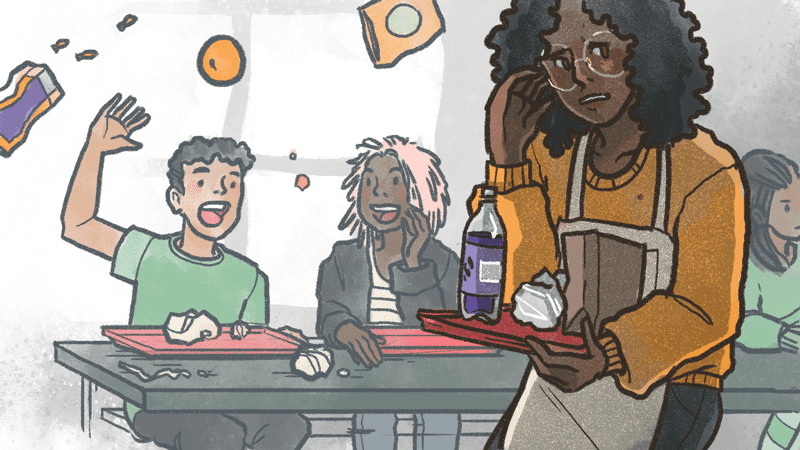Dear Principal Hotline:
HELP! My cafeteria is out of control! I have four cafeteria assistants, but they cannot handle the disrespect, noise, and mess my students are leaving. We have 150 students in the cafeteria at a time. They eat by grade level, and it is a very small space. Any suggestions?
Signed,
I Can’t Hear Anything
Dear I Can’t Hear Anything,
Your cafeteria assistants are pinned down, outnumbered, and clearly losing hope. Depending upon the realities within your district, you may not be able to ask for more staff, but if you can, I would. Each of your monitors is responsible for more students than most classroom teachers, with significantly less training—that’s hard even under the best circumstances.
For the sake of clarity, I’m going to start by assuming you’re dealing with primary students. Do you have an administrative presence during lunch periods? If not, you may be able to tame the situation by simply being there.
Try a color system.
You may also want to establish some sort of easily viewable color system to indicate what level of noise and related behavior are acceptable from moment to moment. One elementary school I worked in had an actual traffic light, which provided a simple means for monitors to signal students when their behavior went too far. After a little bit of time, when that light went red, those students froze immediately.
Establish clear consequences.
It also sounds like it’s time for some clear consequences. If you have a decent rapport with your teachers, they may be willing to spend a few days standing over their students, reinforcing correct behavior, if not during lunch, then after. A stern tone and sitting for 10–15 minutes after they’ve cleared their table can also go a long way toward correcting behavior. The better a whole table is able to follow the rules, the earlier they are able to leave. Peer pressure can limit behaviors from the worst offenders.
Perhaps bringing your monitors into the classroom and requiring an apology from the students after speaking with each class would help them understand why their behavior is problematic. Students have a hard time remembering that adults in the building are able to have their feelings hurt, and even the worst behaviors are sometimes deescalated by helping students understand their behavior impacts those around them.
Use your administrators.
If we’re talking about the secondary level, these strategies will be less effective, especially as the students get older, and you will probably be best served by seeking out individual offenders and placing at least one administrator in the room every period.
As always, check with your peers. How are other schools in your district handling this? Ask your most tenured staff. Perhaps a predecessor found a magic formula for maintaining order. Ask yourself what has changed that may be contributing to the increased chaos. Did you suddenly decrease students’ free time? Maybe switching lunch and recess so that students run around outside before they eat will help.
Brainstorm. Ask for help. Take a breath. Implementing strategies in a way that alters learned behaviors will take time and patience, but you can do this.
Each week, our brave school leadership expert answers your toughest questions about the daily adventures and challenges we all face as we strive to make our schools great places for kids to learn. Have a question? Email it to principalhotline@schoolleadersnow.com.
Plus, check out 4 Great Strategies for Working With Assistant Principals.

